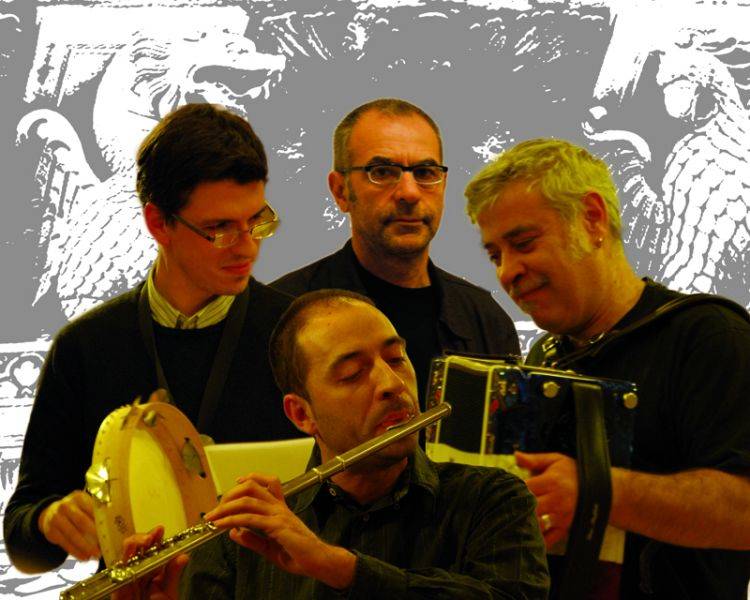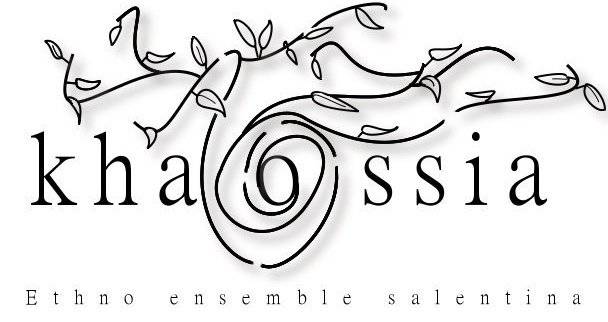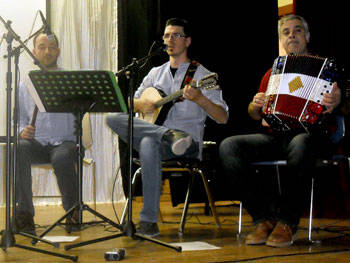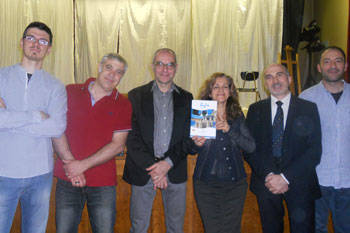Le Grechesce, Italian Folk Music with Khaossia Ethno-Ensamble Salentina
Luca Congedo, Renaissance transverse, Renaissance flute, transverse flute, Turkish flute, tin-whistle; Fabio Turchetti, mouth organ, accordion, guitar; Stefano Torre, Cretan lute, drum, guitar and Giorgio Galanti, narrator, are the members of The Khaossia Ethno-Ensemble Salentina, a folk music group that has just performed at the Scuola d'Italia Guglielmo Marconi in “Le Grechesche.”
The Khaossia Ethno-Ensemble Salentina was founded in 2005 in the city of Cremona, by LucaCongedo and Viviana Calabrese, with the goal of recreating the folk music of Southern Italy, and performing ethnic pieces from the ancient traditions of the Salento, in the Apulia region. Khaossia brings together many different musical traditions, from the Irish and the Hellenic music traditions to re-inventing a new style of oldest and forgotten, sounds. The group is now touring in the United States and has performed at Saint Joseph’s University in Philadelphia, and high schools in New York and New Jersey.
Khaossia works with the permanent project of the Young Politics Council of Comune di Cremona, called “Attraversarte,” which allowed the band to organize live performances, dance and music stages.
The Khaossia group has extensively performed in Italy and abroad, in Croatia in 2005, in France - Paris and Marseille - in 2006 and 2008, in Switzerland in 2008 and last October 2010 in the USA - Philadelphia and New York. In Italy Khaossia took part in the most important folk musical festivals such as La Notte della Taranta in 2005, and many Folk Festivals from 2007 to 2010.
The setting of the “Grechesche” is the Sea, an unknown world dominated by the Republic of Venice, during the 16th century. The members of Khaossia are four slaves on board of a galley owned by the Venetian consul in Otranto, Annibale Basalù. Their songs touch each Venetian port but linger on Otranto whose feel is captured in dreamlike music inspired by Mediterranean folklore.
Luca Congedo, leader of Khaossia said, “being able to tell the story of Salento, my homeland, through my own music is extremely emotional. Presenting and sharing it with high school and college students is amazing. They are totally captivated by it.”
Together, protagonists and audience, they start an imaginary journey towards the sunny coasts of the Land of Otranto, starting from the living rooms of the rich and opulent inhabitants of the Serenissima and touching the ports of the Sea State (Stato da Màr), the lands over which the lion of Saint Mark ruled. For decades the Venetian dominion on the Mediterranean was not only political and economic. The tentacles of the Serenissima allowed lands, no matter how distant, to actually get in contact with and contaminate each other's cultures. They were mainly people who had in common one specific element, the sea, which was considered a source of wealth, life and artistic inspiration.
The music is so magical and captivating that at La Scuola d'Italia, students spontaneously started to dance or clap their hands to the rhythm.
The songs performed were inspired by the imaginary feel of the ports reached by the galley, with the aim to let the “sea” and the “Mediterranean” emerge through each note. This time Khaossia has reworked antique repertory by “folklorizing” four Grechesche (burlesque and colorful compositions) published in 1571 by the Venetian composer Andrea Gabrieli. The texts, fully respected by Khaossia, were written by Antonio Molino also known as Burchiella, a representative of stradiostesca literature, a form of literature that fused together the Venetian language with others, like, in this case, Istrian, Dalmatian and Greek.
Basalù's final destination is the Terra d’Otranto (the Land of Otranto) where the Venetian community had already settled in 836 when they used their warships to help the Longobards and the Byzantines to protect the Adriatic coast from the Saracen pirates. The Venetians established themselves in Salento between the 15th and 18th century, immediately taking over public roles in order to protect their own commercial interests and secure valuable ports. The signs of this forced "brotherhood" between Venice and the Land of Otranto are still evident today in the Palace of the City Government in Lecce and the chapel of San Marco with its inexorable lion. Among the many Venetian families that settled in Salento, Khaossia have chosen to travel with Basalù, the member of a restless family, with an intriguing history, who ruled the city of Otranto for years.
The show successfully recreates the atmosphere of random encounters between different musicians, mostly amateurs and merchants, that used to take place in the Mediterranean ports. This is possible thanks to the use of different musical instruments which were distant both in their genre -refined and popular- and in space and time. Renaissance flute, Cretan lute, violin, tambourine, accordion, guitar, blend naturally together in Khaossia's performances.
“I am very happy we had the chance to welcome Khaossia in our school,” Anna Fiore,
headmaster at the Scuola d'Italia Guglielmo Marconi said, “Our students and teachers alike were greatly interested and enthusiastic. Before the actual show, we had a session with the students where they were explained the historical background of Khaossia's music, starting from the Republic of Venice, to the Renaissance, the 'contamination' and blending of refined musical traditions and folklore elements that capture and link together the music of the Mediterranean Basin, from Greece to Dalmatia, with gypsy rhythms. I believe that the music made by Khaossia fits well within the research and experimentation experiments of some contemporary music groups that recompose inter-culture by a musical standpoint. I'm thinking of the Orchestra di Piazza Vittorio that does something similar, the combine together African and Middle Eastern music with Neapolitan sounds and traditional melodic Italian music. Introducing the kids to these new ways of making music and of inducing social-cultural exchange has great educational value and it is a stimulus to deepen their knowledge and experiences.”
Under the guidance of Prof. Fiore, La Scuola d'Italia is definitely presenting unique and interesting programs that capture all the different nuances of Italian culture. “I really hope Khaossia will return to New York and perform in larger concerts,” she concludes, “I would like to thank Giorgio Galanti, headmaster at the Ufficio Scolastico Regionale della Lombardia (Regional School Office of Lombardy) and educational director in Philadelphia, for having planned this tour and having taught the class before the concert at Scuola d’Italia.”





































i-Italy
Facebook
Google+
This work may not be reproduced, in whole or in part, without prior written permission.
Questo lavoro non può essere riprodotto, in tutto o in parte, senza permesso scritto.